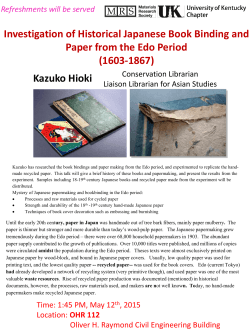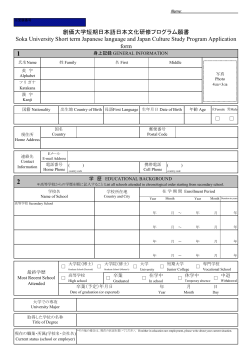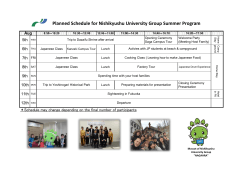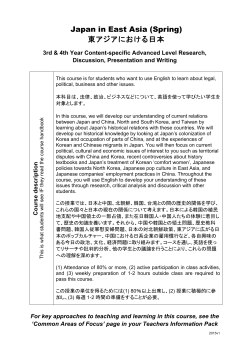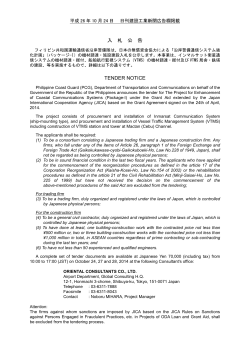
Ukiyo-e in Edo period publishing culture
Workshop: Ukiyo-e in Edo period publishing culture Date: Venue: Organizers: Friday 10 April 2015 Sainsbury Institute, 64 The Close, Norwich NR1 4DH Sainsbury Institute for the Study of Japanese Arts and Cultures Chuo University Workshop Programme 9.30 Welcome and coffee Morning session | Chaired by Suzuki Toshiyuki 9.45-10.15 Suzuki Toshiyuki (Chuo University) "Distribution routes of ukiyo-e" 10.15-10.45 Ellis Tinios (Leeds University) "Adapting Chinese books for the Japanese market: a study in bibliographic translation" 10.45-11.45 Session discussion (Lunch break) Afternoon session | Chaired by Ronald Toby 12.30-13.00 Christian Dunkel (Berlin Library) "Publishing and re-publishing a long-time bestseller: the case of Miyako meisho zue" 13.00-13.30 Laura Moretti (Cambridge University) "Japanese early-modern ephemera: the world of kobanzuke" 13.30-14.15 Session discussion (break) 14.30-15.00 Matsumura Masako (Hiraki Ukiyo-e Museum) "From small and large surimono to nishiki-e" 15.00-15.30 Matthi Forrer (Rijksmuseum voor Volkenkunde, Leiden) "The meaning of illustrated books in the printing culture" 15.30-16.00 Ronald Toby (Illinois University)* "'Chōsenjin' and 'Tōjin' in pre-modern Japan" 16.00-16.45 *via Skype Session discussion 17.00-18.00 Final discussion chaired by Professor Richard Bowring Professor Ronald Toby 'Chōsenjin' and 'tōjin' in pre-modern Japan Summary Hanabusa Itchou, a leading artist of Genroku and Kyōhō eras (1688-1736), was devoted to creating paintings and had virtually no involvement with the print publishing culture during his lifetime, which made him unique from the likes of Hishikawa Moronobu and Okumura Masanobu. After his death, however, his disciples and followers posthumously published six albums containing Itchō's work in Hōreki and Ansei eras (1751-1781), which fuelled an Itchō boom. Itchō's work often contains images of 'chōsenjin', 'tōjin' and Japanese dressed as foreigners. The figures also appear in the posthumous albums. Close observation will show, however, that the depicted figures differ in a multitude of ways when compared to those found in Itchō's paintings. This paper will explore the significant role the paintings and surimono prints played, which reference Itchō's depiction of foreigners. It will compare the figures in Itchō's paintings versus those found in prints and paintings made by other artists following Itchō's examples with the image of 'tōjin' included in 'Itchō album' as an example. Biography Selected Publications Ronald P. Toby, a historian of early modern Japan, is Professor Emeritus of History and East Asian Studies at the University of Illinois, and held a professorship in Korean Studies at the University of Tokyo. He received his Ph.D. in Japanese history from Columbia University in 1977. Toby publishes in both English and Japanese on pre-modern Japanese international history, cultural, social, cartographic and visual history. His books include State and Diplomacy in Early Modern Japan (Princeton, 1984); The Emergence of Economic Society in Japan, 1600-1859 (co-edited, Oxford, 2004); Japan and Its Worlds: Marius B. Jansen and the Internationalization of Japanese History (co-edited, I-House Press, 2007); ‘Sakoku’ to iu gaikō' (“The politics of ‘seclusion,’” Shōgakukan, 2008); and Ezugaku nyūmon (“Introduction to Cartology,” co-edited, University of Tokyo Press, 2011). In 2012 he was named the first recipient of the National Institutes for the Humanities Prize in Japanese Studies. State and Diplomacy in Early Modern Japan (Princeton University Press, 1984) Kindai nihon no kokka keisei to gaikō (Sobunsha, 1990) Kanryū suru bunka to bi (Edited volumne, Kadokawa Shoten, 2002) Emergence of Economic Society in Japan, 1600-1859 (Edited volume, Oxford University Press, 2004) Nikkanchū no kōryū: hito, mono, bunka(Co-author, Yamakawa Publishing, 2004) 'Sakoku' to iu gaikō (Shogakukan Inc., 2008) Ezu gaku nyūmon(Edited volume, University of Tokyo Press, 2011) 近世日本における「朝鮮人」・「唐人」像の草創・融通について 元禄∼享保期の代表的な絵師英一蝶、菱川師宣や奥村政信らと違って、肉筆画のみに専念 して一生出版文化と無縁であった。ところが、一蝶歿後の宝暦∼安永期に、弟子などが、 一蝶作品や粉本に基づき、六点の画譜などを上梓して、一蝶ブームを呼び興した。 ところで、一蝶作品の内、「朝鮮人」・「唐人」や、唐人装束の和人を画いた作品が多く 含まれており、そうした絵の何点も、上記の画譜に収録されることとなった。しかしなが ら、画譜の図版を現存する原画(肉筆)と比べると、様々の変容に気付く。報告は、『一 蝶画譜』所収の「唐人」図を事例に、一蝶の原画と版本の図との比較や、他の絵師による 一蝶画を借用して画かれた肉筆画や 物が、いかなる媒体役を果たしたかを検討すること にする。 Dr Ellis Tinios Adapting Chinese books for the Japanese market: a study in bibliographic translation Summary When Edo-period publishers issued their own editions of Chinese books they rarely sought to produce facsimiles. They replaced the ‘butterfly’ bindings decchōsō 粘葉装 characteristic of imported painting manuals with fukurotoji 袋綴 bindings. In the case of illustrated poetry anthologies, rather than present each poem and its accompanying illustration in the Chinese manner on opposite sides of a folded leaf chō 丁, Japanese publishers presented image and poem on facing pages. A late Ming erotic book was subjected to another kind of bibliographic translation: each single-page image of the original was extended in the Japanese edition to fill a two-page spread mihiraki 見開き. The latter was firmly established as the norm in Japanese book design from the 1660s. (Japanese editions of Chinese erotica rank among the earliest ukiyo-e books.) Japanese publishers did not adhere slavishly to their Chinese models. They adapted the physical, textual and visual elements of the originals to conform to Japanese preferences. Their goal was to provide an avid book-buying public with accessible books in user-friendly formats. Biography Selected Publications Dr. Ellis Tinios is Honorary Lecturer in History at the University of Leeds, Visiting Researcher at the Art Research Centre, Ritsumeikan University, and faculty of the Rare Book School, University of Virginia. His recent publications include Understanding Japanese woodblock-printed illustrated books with Suzuki Jun (Brill, 2013), ‘Japanese illustrated erotic books in the context of commercial publishing, 1660-1868’ in Japan Review No.26 (2013), and Japanese Prints: Ukiyo-e in Edo, 1700-1900 (British Museum Press, 2010). Mr Christian Dunkel Publishing and re-publishing a long-time bestseller: the case of Miyako meisho zue Summary In 1780 the Miyako meisho zue 都名所図会 - the first title of what was to become a type of publication that gained widespread popularity in the second half of the Edo period - was published in Kyoto. The subject of the book was nothing novel, it introduced the readers to the famous places of Kyoto, and as a matter of fact the authors relied heavily on previously published material. But they also combined elements found in topographies, gazetteers and illustrated guide books in a fresh manner, which proved to be a big commercial success that eventually more then seventy multi-volume titles featuring various provinces, towns and pilgrimage routes on the Japanese islands were published. The Miyako meisho zue itself underwent numerous editorial revisions and remained ‘in print’ for nearly a century, right up to the beginning of the Meijiperiod. The printing blocks changed hands several times and even a second set of blocks was carved and used for printing simultaneously with the original blocks. This paper will focus on the publishing history of the Miyako meisho zue by analysing information derived from the colophon, advertising lists and other parts of the book, drawing on copies from the digital collections of the Staatsbibliothek zu Berlin, other institutions and private collections. It will also try to explore possible reasons for the continued revisions and the re-carving of the entire set of printing blocks by comparing it with other cases of re-edited Kyoto guide books like the Keijō shōran 京城勝覧, originally published in Hōei 3 (?) (1706), republished in Tenmei 4 (1784), or the Miyako meisho tebiki annai 都名所手引案 内, published in Hōreki 13 (1763) and Kaei 1 (1848) respectively. Biography Christian Dunkel is Deputy Head of the East Asia Department at Staatsbibliothek zu Berlin. He graduated from Humboldt-University in Berlin. After spending two years at Ritsumeikan University in Kyoto he joined the section for East Asian Art History at the Art History Department, University of Zurich in 2008. In 2011 he became special subject librarian for Japan and curator of the collection of pre-modern Japanese material at the East Asia Department at Staatsbibliothek zu Berlin where he is now deputy head of the department. His research interests include the pre-modern publishing culture of Japan and its bibliography. Dr Laura Moretti Japanese early-modern ephemera: the world of kobanzuke Summary Single-sheet prints were an integral part of the Edo-period commercial publishing industry and their scope went well beyond that of ukiyo-e. This paper explores this under-researched facet of early-modern ephemera by examining the kobanzuke printed by the Osaka publisher/bookseller Shioya Kihei. Biography Laura Moretti is Lecturer in pre-modern Japanese Studies at the University of Cambridge. She is also Director of Studies at Emmanuel College. She obtained her BA and MA in Japanese Studies at Università Ca’ Foscari Venezia (Italy), and in 2003 earned her Ph.D. at the same university. Her study focused on Edo-period literature with interests in 17th-century Japanese prose. She has served as Secretary of the European Association of Japanese Resource Specialists from 2008 to 2012 and is a member of the Extended Council of the European Association of Japanese Studies since 2011. Selected Publications 2013 ‘Onna enshi kyōkun kagami and Onna genji kyōkun kagami: sexual education through entertaining parody’, Japan Review 26, Special Issue on Shunga, pp. 195-212. 2012 ‘The Japanese early-modern publishing market unveiled: a survey of Edoperiod booksellers’ catalogues’, East Asian Publishing and Society, 2/2, pp. 199-308. 2011 ‘Kanazōshi revisited: reconsidering the beginnings of Japanese popular literature in print’, Monumenta Nipponica, 65/2, pp. 297-356. 2010 近世初期・前期の散文文学における『伊勢物語』の書き直し、パロ ディーおよび新展開 (‘Kinsei shoki – zenki no sanbun bungaku ni okeru Ise monogatari no kakinaoshi, parodi oyobi shin tenkai), in Yamamoto Tokurō e Joshua Mostow (eds.), 伊勢物語創造と変容 (Ise monogatari sōzō to hen’yō), Osaka, Izumi shoin, pp. 269-301. 2009 Japan Forum 21 (3): guest editor of special issue on ‘Narrativity and fictionality in Edo-period prose literature’, pp. 116. 2009 ‘On the edge of narrative: towards a new view of the 17th-century popular prose in print, Japan Forum 21 (3), pp. 325-345. Miss Matsumura Masako From small and large surimono to nishiki-e Summary Ukiyo-e, as an artistic style created by Hishikawa Moronobu, is considered to be a unique form of art that catered to the commoners rather than the privileged. The tradition is also known for developing the highly sophisticated block print techniques to produce nishiki-e or polychrome prints. Particularly famous is how the more refined polychrome nishiki-e print came to supersede the previously common benizuri-e with their limited color palette when the tradition of exchanging new year's print at 'Daishō e' gatherings experienced a popularity rise in 1765. This paper looks at investigating the technical achievements in the printing industry that made nishiki-e a viable commercial product by examining 'daishō' surimono prints and works by Suzuki Harunobu, which were highly prized by the likes of Kyosen and Sakei who hosted 'daishō e' gatherings. A particular type of polychrome woodblock prints known as mizue produced during the same period, but for a short duration, will also be discussed. Biography Selected Publications Matsumura Masako M. Phil. Gakushuin University Curator, Hiraki Ukiyo-e Foundation 'Fugaku hyakkei ni tsuite: nihen wo chūshin to shite' (Hiraki ukiyo-e bijutsukan tayori, no. 9, November 1998) 'Kanadehon chūshingura no sekai' in Genroku ryōran exhibition catalogue (EdoTokyo Museum, 1999) 'Ningen banji Saigyō ga neko' (Hiraki ukiyo-e bijutsukan tayori, no. 11, March 2000) 'Kentō no hatsumei' in Shukan Asahi hyakka sekai no bungaku 84, March 2001) 'Benizuri-e kenkyu: Benizuri-e kara nishiki-e ni itaru gihō no hensen ni tsuite' in Kajima Bijutsu Zaindan 2001 nendo, 'Bijutsu ni kansuru chōsa kenkyū' josei Hokusai Hiroshige no fugaku sanjū rokkei hitsu kurabe: edo kirie-zu Fujimi jūsan-shū yochi zenzu de tadoru (Jinbunsha, 2005) Hiroshige no shokoku rokujūyoshū tabi geshiki: dai nihonkoku saizu de meguru (Jinbunsha, 2005) 'Suzuki Harunobu no mizu-e' in Hōjō no nihon bijutsu (Professor Kobayashi Tadashi's festschrift, 2012) 'Zashiki hakkei ni tsuite: sono hatten to keishiō' in Ukiyo-e no bi: Hiraki korekushon no meihin (2012) 「大小 物から錦絵へ」 菱川師宣を創始とする「浮世絵」は、特権階級ではない庶民を需要層として設定された世 界的にも珍しい芸術とされ、「錦絵」という高度な多色 技法にたどり着いたことでも独 特である。本格的な多色 である「錦絵」は、明和2年(1765)に「大小会」という絵暦 交換会の流行を境に、それまでの色彩数を制限された「紅 絵」から格段の発展を遂げた ことは著名である。 本報告では、大小会を主宰した巨川や莎鶏ら好事家に重用された鈴木春信の作品を中心に 、 物である「大小」を通して、販売物としての「錦絵」へと発展を遂げた技術を検証す る。その際に、この時期に一時的に制作された独特な多色 木版画「水絵」を取り上げ、 考察を加える。(295 文字) 学習院大学大学院博士課程前期修了。 公益財団法人平木浮世絵財団学芸員として勤務。 「富嶽百景について ―二編を中心として」 1998 年 11 月 (平木浮世絵美術館便り№9 ) 「仮名手本忠臣蔵の世界」 1999 年 元禄繚乱展図録 江戸東京博物館 「人間萬事西行猫」2000 年 3 月 (平木浮世絵美術館便り№11) 「見当の発明」2001 年 3 月 (週刊朝日百科世界の文学 84) 「紅 絵研究 −紅 絵から錦絵に至る技法の変遷について」 財団法人鹿島美術財団 2001 年度「美術に関する調査研究」助成 『北斎・広重の冨嶽三十六景筆くらべ-江戸切絵図富士見十三州輿地全図で る』 2005 年 人文社 『広重の諸国六十余州旅景色-大日本国細図名所図会で巡る』2005 年 人文社 「鈴木春信の水絵」2012 年 (『豊穣の日本美術』小林忠先生古稀記念論集) 「座舗八景について ―その発展と継承―」 2012 年 (「浮世絵の美 −平木コレクショ ンの名品―」) Dr Matthi Forrer The meaning of illustrated books in the printing culture Summary Quite recently, I was really puzzled to find that three scholars in different fields managed to come up with totally different figures concerning Hokusai’s output in the book format (Jack Hillier 272 [1980]; Nagata Seiji 276 [1985]; Richard Lane 290 [1989]). And indeed, talking about the ‘book format’, it may be good to ask what that is and what it represents. Is it a vehicle for artists, or maybe some commodity for book publishers? And what is its role and meaning in the printing culture? How, for example, should we deal with passages discussing developments in the Tenmei period (1780s), such as: Shigemasa, as we have seen, after doing brilliant things and seeming to have the leadership of Ukiyo-ye within his grasp, had not cared seriously to pursue his successes in the domain of the nishiki-ye. None the less, he was the most influential master in Anyei. (Binyon & Sexton, 88) Or: Was it Masanobu or Kiyonaga who set the fashion for these types of women of grand build and stature? /…/ But the rivalry was not to last. Masanobu, like Shigemasa, did not follow up his success. He produced at least one masterpiece, again a double-page composition rather than a diptych, the group of holiday-makers in an iris garden listening to a cuckoo. /…/ But after this time Masanobu practically disappears, to become more famous as a writer under the name of Kyōden. (Binyon & Sexton, 90) And yet, Shigemasa would figure as number 8 in the top ten of book illustrators in the 1770s, Masanobu taking the 5th position, Kiyonaga 3rd (with Torii Kiyotsune being number 1); and in the 1780s, we find Shigemasa as number 4, Masanobu taking the 2nd position, with Kiyonaga just in between, taking the 3rd position (this time Kitao Masayoshi taking position 1). And in the 1790s, Shigemasa would be holding the 3rd position, Masanobu ranking 8th, Kiyonaga 10th, Masayoshi taking the 4th position. The first and second positions are then held by Toyokuni and Jippensha Ikku. With Shigemasa – as Binyon & Sexton maintain – not caring ‘seriously to pursue his successes in the domain of the nishiki-ye’ in the 1780s, it is certainly quite surprising to see him climb in the book format from the 4th position in the 1780s to the 3rd position in the 1790s – indeed, sufficient reason to reconsider the history of print culture in Japan, I would say. Biography Dr Matthi Forrer is senior researcher of the Japan collections of the National Museum of Ethnology, Leiden, and has published extensively on Hokusai and Edo-period culture, including ukiyoe, book publishing, and kyōkabon, as well as on Dutch-Japanese relations. Professor Suzuki Toshiyuki Distribution routes of ukiyo-e Summary In Edo there was a sharp rise in the number of small print sellers called ezōshi ya from around the late 18th century that specialised in ukiyo-e sales. In Kamigata (present day Osaka region) there were a growing number of wholesalers trading Edo printed ukiyo-e to attest to the distribution route functioning firmly and helping to reward increase in production rate. By then ukiyo-e was fast becoming a popular merchandise that was distributed nationwide. What were goods once expected for circulation within Edo city became a huge commercial potential. The number of ukiyo-e makers flourished in Edo to breed an important industry. Craftsmen who were responsible for carving blocks and printing prints formed groups to secure a more stable labour structure. Artist studios, such as the Utagawa school which emphasised traditional teacher-todisciple relationship, also expanded their activities. By the end of the Edo period, shops specialising in selling nishiki-e and ezōshi-e were aplenty at a national level, whereby finding a regional merchant that did not stock Edo printed ezōshi was virtually impossible. The trend suggests that during this period, information pertaining to sōshi was readily available throughout the country. Biography Selected Publication Professor Suzuki is Professor, Faculty of Letters at Chuo University. His research focus is on early modern Japanese literature. He graduated from Faculty of Letters, Chuo University in 1979, and the Master Program, Graduate School of Letters at the same institution in 1981. Currently studies include the culture of publishing in general in early-modern Japan, primarily in terms of the distribution of publications in order to understand the time from the foundation of the Japanese culture. Professor Suzuki was awarded the Japan Society of Publishing Studies Award in 2005, and the Gesner Award in 2008. Love of Reading in Edo: Self-Instruction Readers and Distribution of Publications [Edo no Dokusho Netsu: Jigaku suru Dokusha to Shoseki Ryutsu] (Heibonsha Sensho, Heibonsha, 2007) Bibliography for Studies on Early-Modern Publications, the augmented and revised version [Zouho Kaitei Kinsei Shoseki Kenkyu Bunken Mokuroku] (Perikansha Publishing, 2007) Illustrated Story Book Stores: Shops of Wood Block Prints in Edo [Ezoushiya: Edo no Ukiyoe Shoppu] (Heibonsha, 2010) Full of Edo Books: The Context of Publishing in Edo Shown on Yellow-Covered Books [Edo no Hon Zukushi: Kibyoushi de Yomu Edo no Shuppan Jijou] (Heibonsha, 2011) Juzaburo Tsutaya, the new edition [Shinban Tsutaya Juzaburo] (Heibonsha, 2012) Introduction to the Theory of Historical Materials on the Distribution of Publications [Shoseki Ryutsu Shiryo Ron Josetsu] (Bensei Publishing, 2012) 浮世絵の流通回路 絵草紙屋と呼ばれる浮世絵小売りの専門店が18世紀末頃から江戸市中に急増する。流通 回路の充実は、生産量の増大と直結する。上方でも江戸出来の浮世絵を扱う問屋が出来、 浮世絵は全国的な流通に乗る商品となっていく。江戸という都市での流通しか想定してい なかったものが、大きな流通力を備える商品として市場を拡大していく。浮世絵という商 品を柱とした一大産業が江戸に成立した。彫・ に関わる下職も厚みのある安定的な構造 をもつ職人集団として成長し、歌川派のような、職人的徒弟組織を備えた画工集団もその 規模を拡大していく。幕末になると「錦絵」「絵草紙」を主要商品として看板に掲げる店 が全国規模で増加し、江戸出来の草紙類の至らぬ地域はほとんどなかったと思われる。そ れは、草紙類の備える情報が均一的にこの国全体に行き渡る世の中になったことを意味す る。 1956 年 北海道生。中央大学教授。 1979 年 中央大学文学部国文専攻卒業 1985 年 同大学院博士課程 1992 年 中大文学部専任講師 1998 年 教授 『蔦重出版書目』(1998 年、青裳堂書店) 『一九が町にやってきた―江戸時代松本の町人文化』(2001 年、高美書店) 『江戸の読書熱―自学する読者と書籍流通』(2007 年、平凡社) 『絵草紙屋―江戸の浮世絵ショップ』(2010 年、平凡社) 『江戸の本づくし―黄表紙で読む江戸の出版事情』(2011 年、平凡社) 『書籍流通史料論序説』(2012 年、勉誠出版) 『新版 蔦屋重三郎』(2012 年、平凡社) 『近世・近代初期 書籍研究文献目録』(2014 年、勉誠出版)
© Copyright 2025
